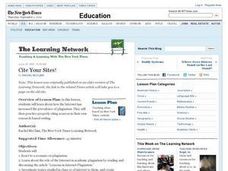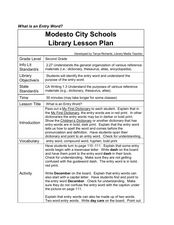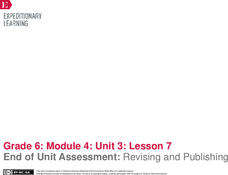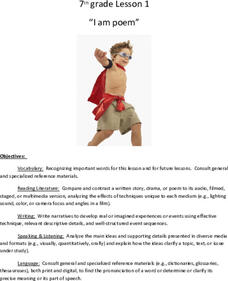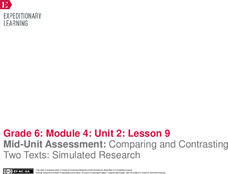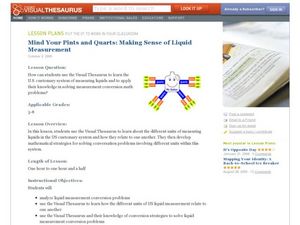Curated OER
Making Sense of Homographs
What is a homograph? Develop your students' vocabulary with a word association tool. Language arts classes discover what a homograph is and how it can be used as a visual thesaurus. They discover the other uses for homographs...
Curated OER
Take the Prefix Challenge
Students form words using prefixes. In this prefix lesson, students compete in a "prefix challenge" to see which team can combine a set of twelve prefixes with a set of twelve words fastest. Students enter their words in...
Curated OER
Figurative Language in Toni Morrison's "A Mercy"
In order to read and respond to Toni Morrison's A Mercy in this figurative-language lesson, students discuss the differences between a literal and a figurative interpretation of a text. They explore figures of speech using a...
Curated OER
Cite Your Sites
What information would you find in an almanac that you would not find in an atlas? What is the difference between a dictionary and a thesaurus? Using a Cite Your Sites worksheet on which they record their observations, groups participate...
Curated OER
Dictionary Work - Entry Words
Second graders examine the use of entry words in the dictionary. In this dictionary use lesson, learners look at guide words in a children's dictionary as the teacher/librarian describes the characteristics of each entry. They complete...
Curated OER
Making an Argument: Effective use of Transition Words
Work on using transition words in context by prompting elementary and middle schoolers to write their own persuasive essays using transition words. They explore new forms of transition words and examine how they are used in an editorial...
Curated OER
Nym Family
List and identify words for each part of the "Nym" family: synonyms, antonyms and homonyms. Middle schoolers place words in the correct category, then find the corresponding mate in a dictionary or thesaurus.
Curated OER
Writing: Narrative, Expository, Persuasive, and Descriptive
If you are interested in having a basic framework for teaching expository, narrative, persuasive, and descriptive writing, this resource may help; however, you will have to find information on the different forms of writing to share with...
EngageNY
Resource Materials and Gathering Information: Reading Another “Choice” Text from the Research Folder
Look it up. Scholars use a dictionary and thesaurus to verify the meaning of the research vocabulary words they defined in the previous activity. They then use sticky notes to write a synonym for each word. Finally, individuals choose a...
Curated OER
New Hampshire Unplugged
Young historians explore how technology and science affected life in the state of New Hampshire. They define technology and give personal experiences of how technology affects people and how people have used technology. They compare the...
Curated OER
Children Around The World
Students read a multicultural book called "This Is the Way We Go to School" by Edith Baer and Steve Bjorhman. They become culturally aware of the different nationalities around the world and different ways that they may do things on a...
EngageNY
End of Unit Assessment: Revising and Publishing
Dictionaries, thesauruses, word walls, oh my! Pupils use several resources to revise their position papers to include appropriate vocabulary. Then, after peer editing, scholars write the final drafts of their essays and self-assess using...
Utah Education Network (UEN)
7th Grade Poetry: I Am Poem
A study of Alfred Noyes's poem "The Highwayman" opens a lesson about narrative poetry. Scholars read the poem and compare it to the animated video version using a worksheet. Learners look at models and use a template to craft an "I Am"...
Curated OER
Arctic Writing
Fifth graders analyze photographs in order to write descriptively. In this descriptive writing lesson plan, 5th graders use the Internet to research and view photographs of the arctic. Students use descriptive language to...
EngageNY
Mid-Unit Assessment: Comparing and Contrasting Two Texts: Simulated Research
Shoo fly. Scholars read DDT Spray Scares Mosquitoes Away, Study Finds and You Think You Have It Tough? to complete a mid-unit assessment. The learners compare and contrast author presentation and conduct a credibility check on each...
Curated OER
Dragonwings: Explore Chapters 1-5
If you are beginning Laurence Yep's Dragonwings, this will provide activities for the first five chapters. The objectives include making connections to oneself and the world, organizing information and events, vocabulary acquisition,...
Curated OER
Descriptive Writing and Review
This is my type of lesson! Learners read the poem, "The Deserted House" by Mary Coleridge, then complete a series of activities which encourage strong descriptive writing and sensory detail. They'll practice outlining, sentence writing,...
Curated OER
Varied Word Choice
Fifth graders examine how to use a variety of word choices when writing. They discuss how using more descriptive words leads to a more varied word choice, watch a teacher-created PowerPoint presentation, and using a Thesaurus replace...
Curated OER
Mind Your Pints and Quarts: Making Sense of Liquid Measurement
Young scholars convert among liquid measurement units. In this measurement lesson, students use Visual Thesaurus to gather information about customary units for liquid measure such as cup, pint, and quart, then young scholars practice...
Curated OER
Eating Right with a Little Help From the VT
Students explore the food pyramid. In this nutrition instructional activity, students identify the 5 food groups and sort foods according to the group in which they belong. Students use the Visual Thesaurus to complete a food groups...
Curated OER
What's Your Genus? Scientific Classification and the VT
Young scholars understand the definition of binomial nomenclature. For this binomial nomenclature lesson, students classify ordinary animals by seeking their scientific names. Young scholars participate in a knowledge hunt using binomial...
Curated OER
Sorting Out Homophones in Roald Dahl's
Students explore the concept of homophones. In this homophone lesson, students use a selection from the book Matilda to review homophones. Students use a web to identify homophones.
Curated OER
Do You Haiku? We Do!
Third graders try their hands at writing Haiku, a form of Japanese poetry. Haiku is usually 17 syllables in three-line form. This engaging lesson has many excellent worksheets and website imbedded in the plan. They share their finished...
Curated OER
Words That Hold Court
Students research legal terminology used in the Supreme Court. In this legal terminology lesson, students study a quote from President Obama about the Supreme Court. Students make a list of facts about the Supreme Court and the justices...





